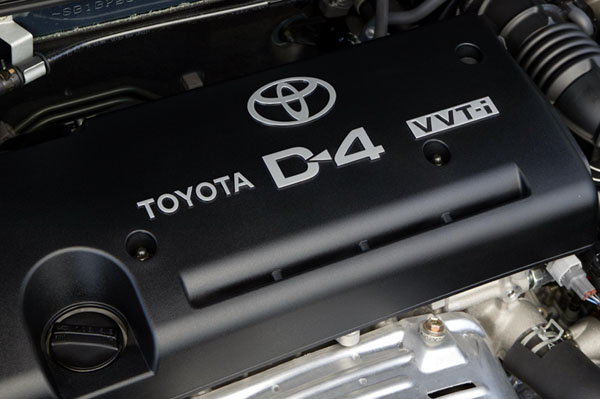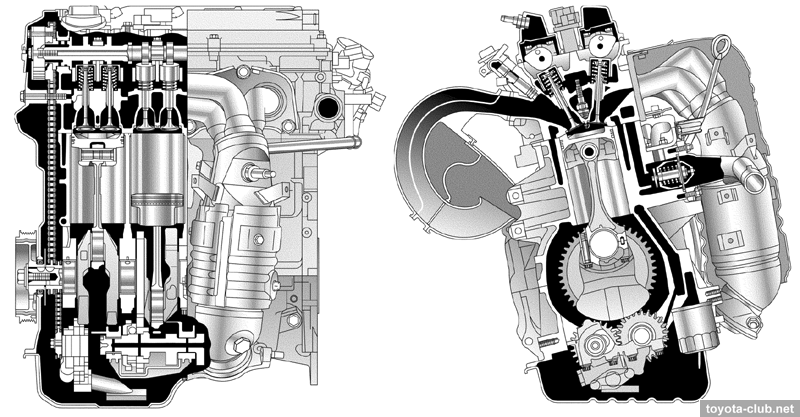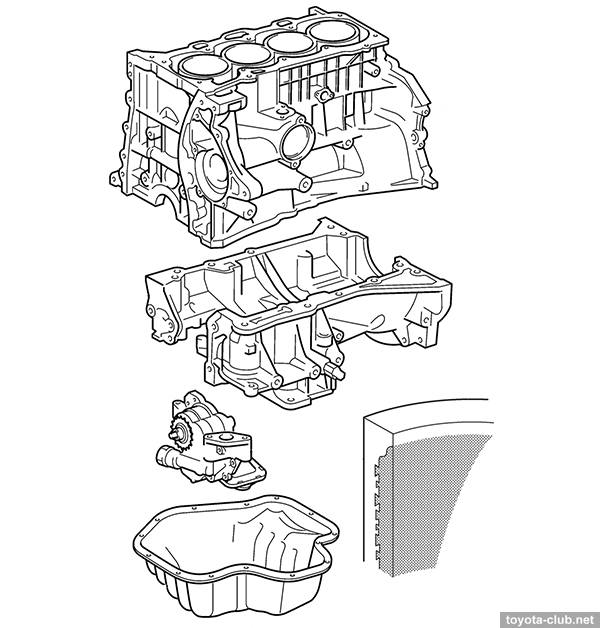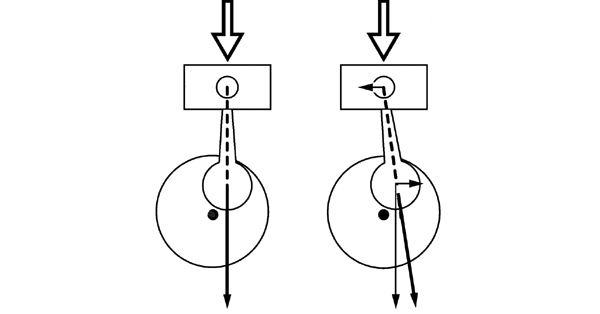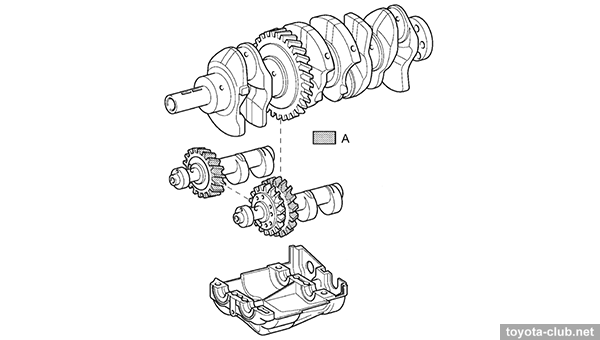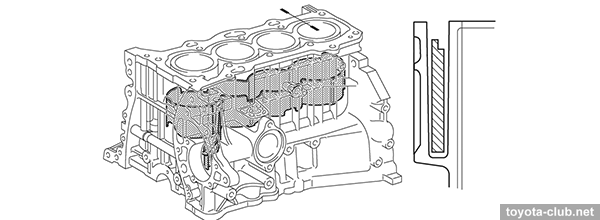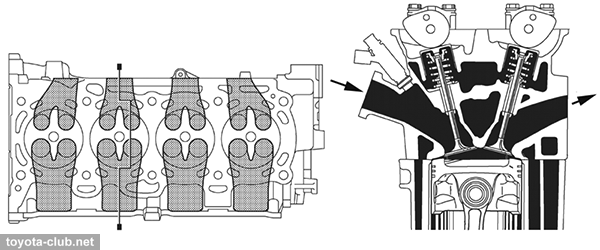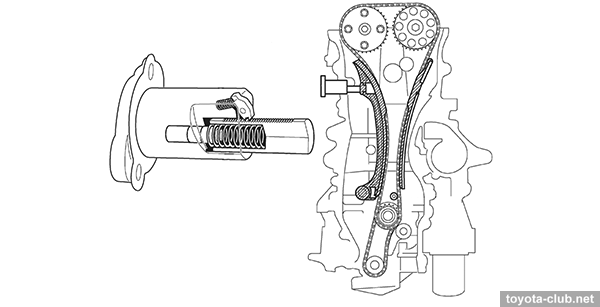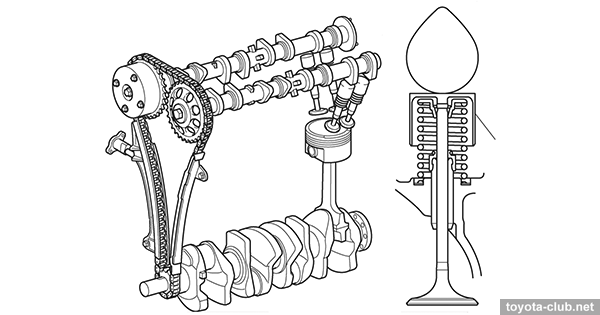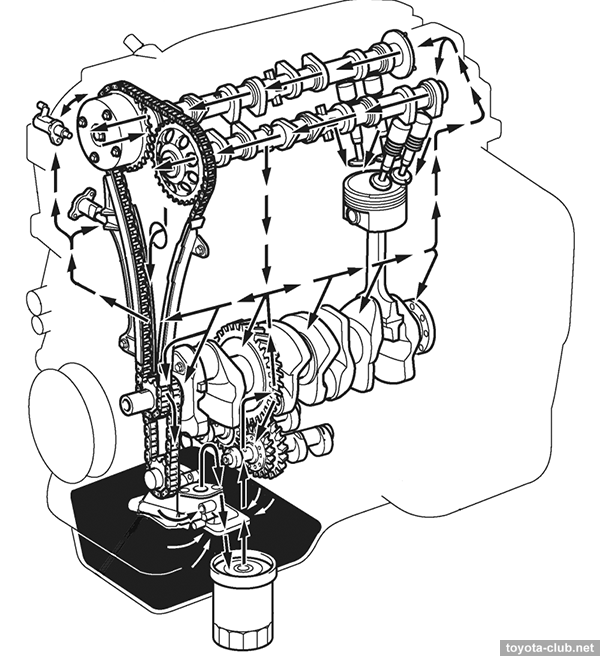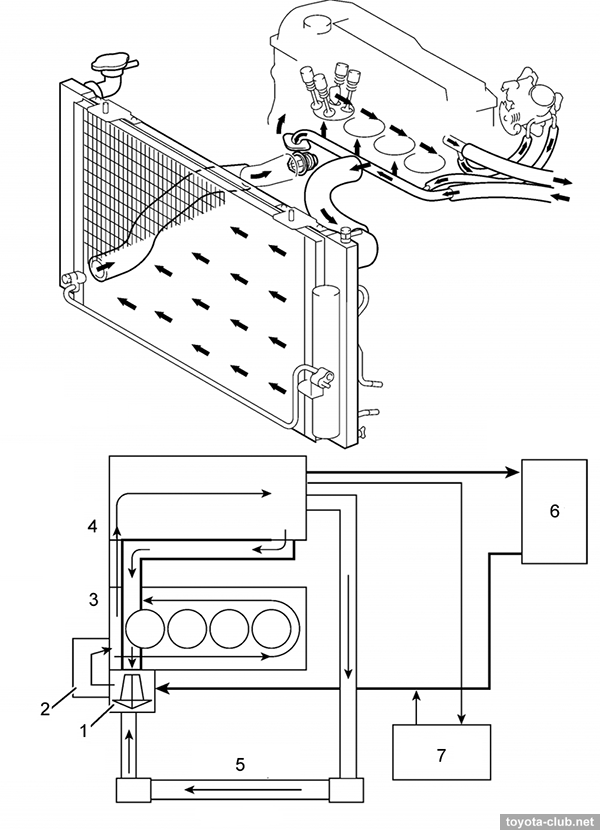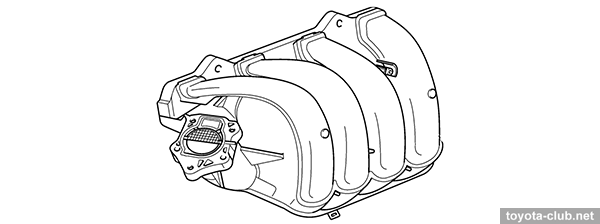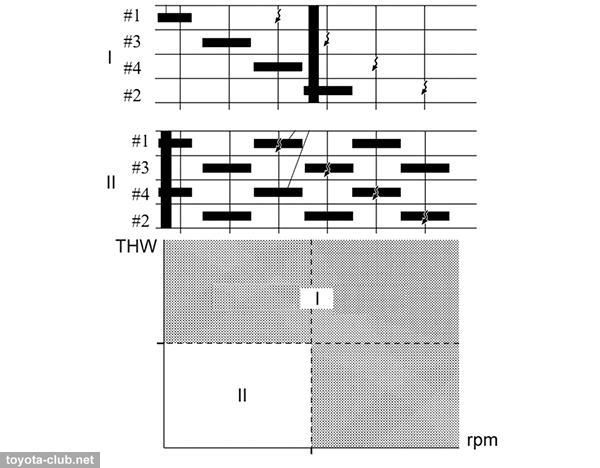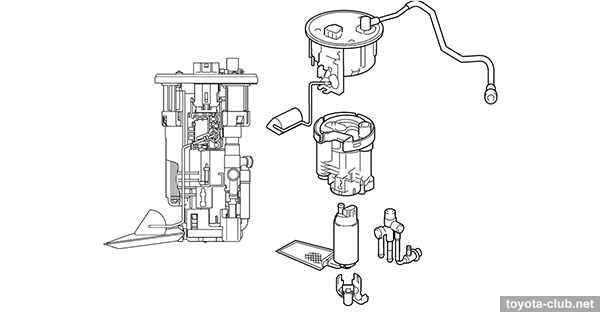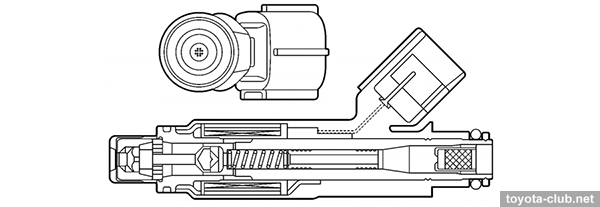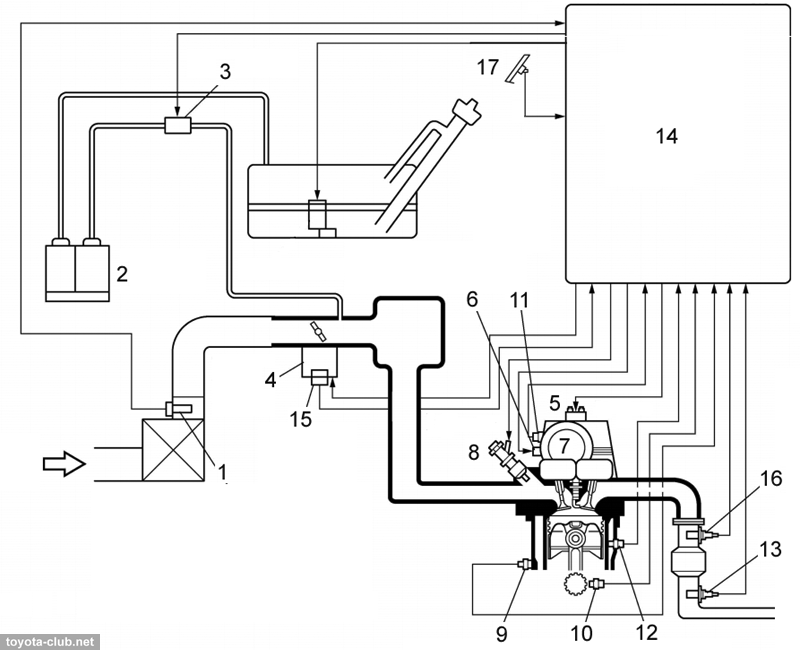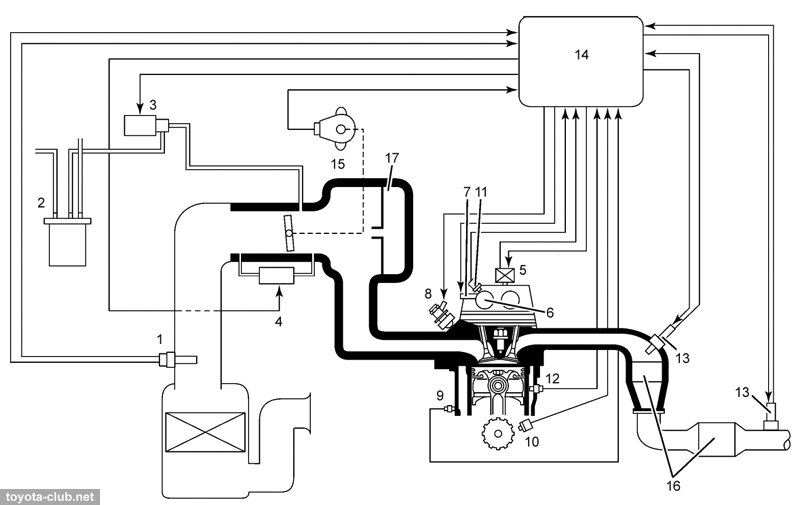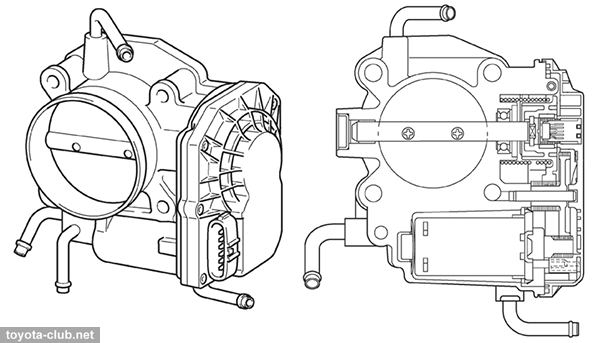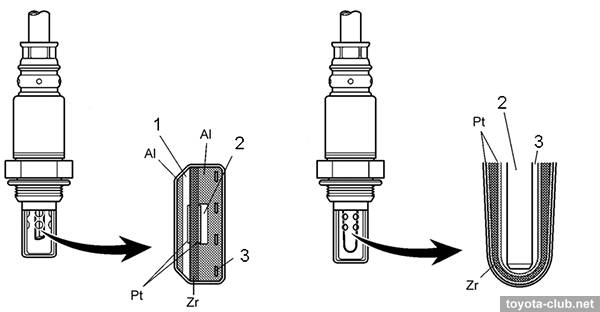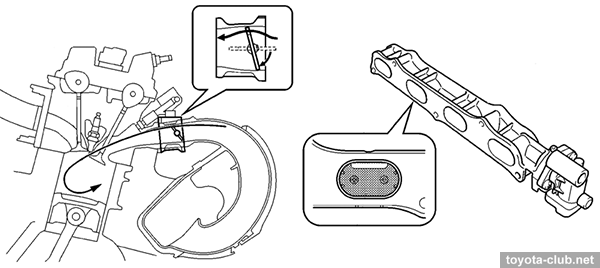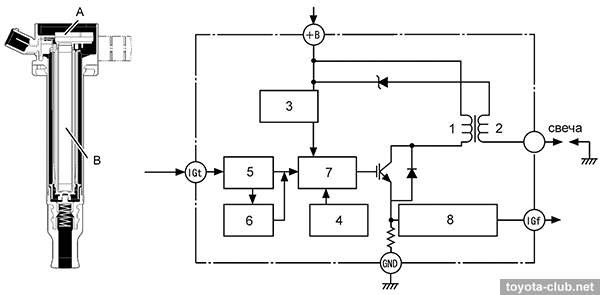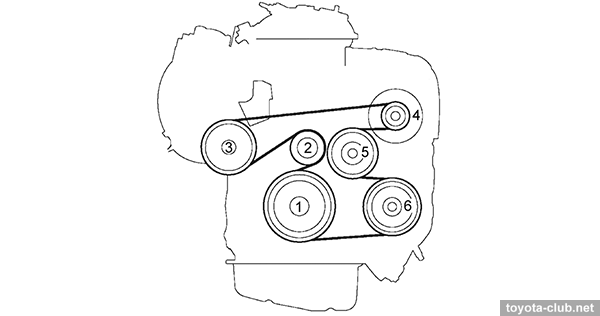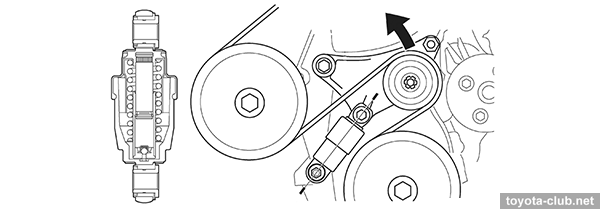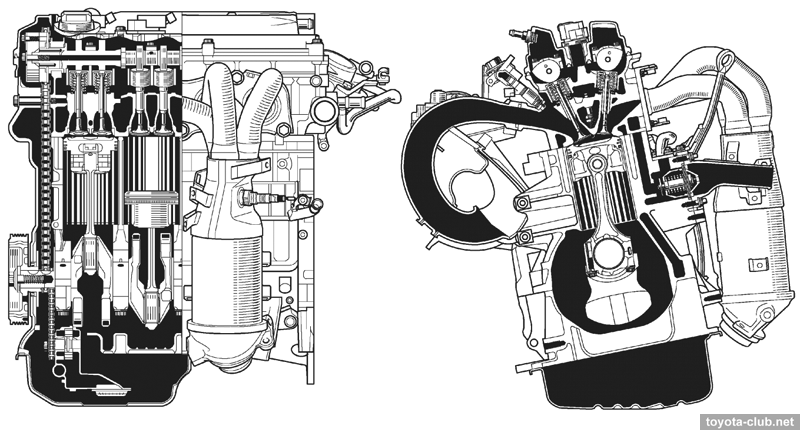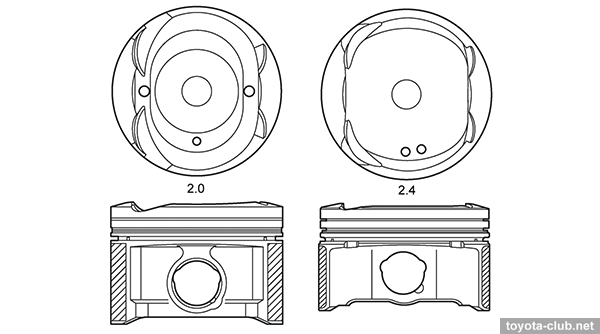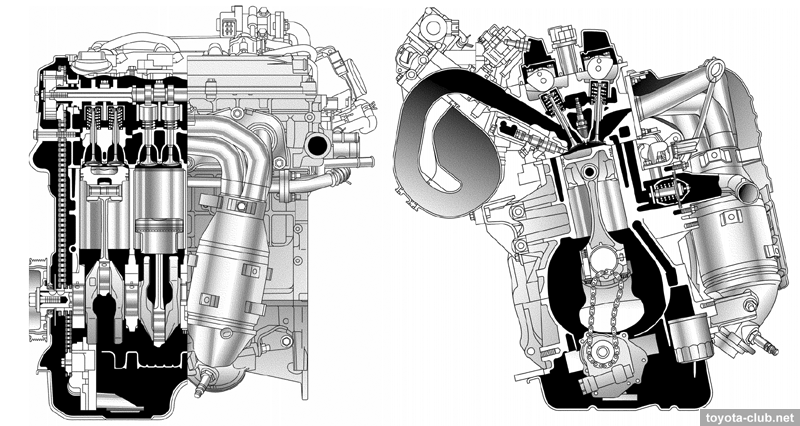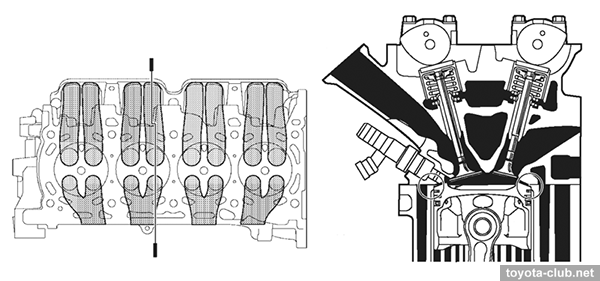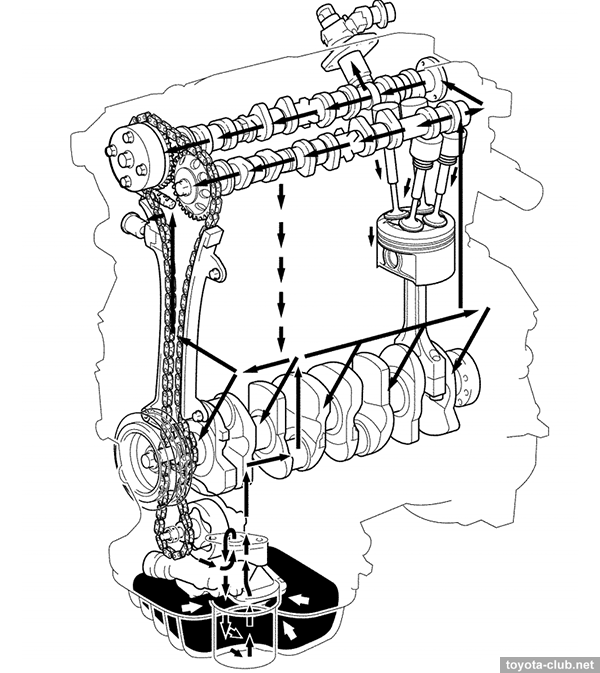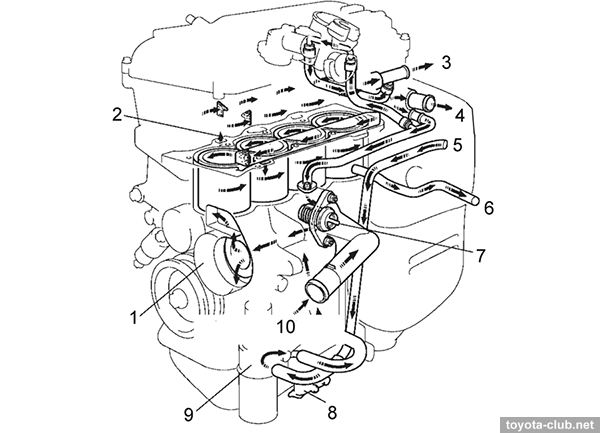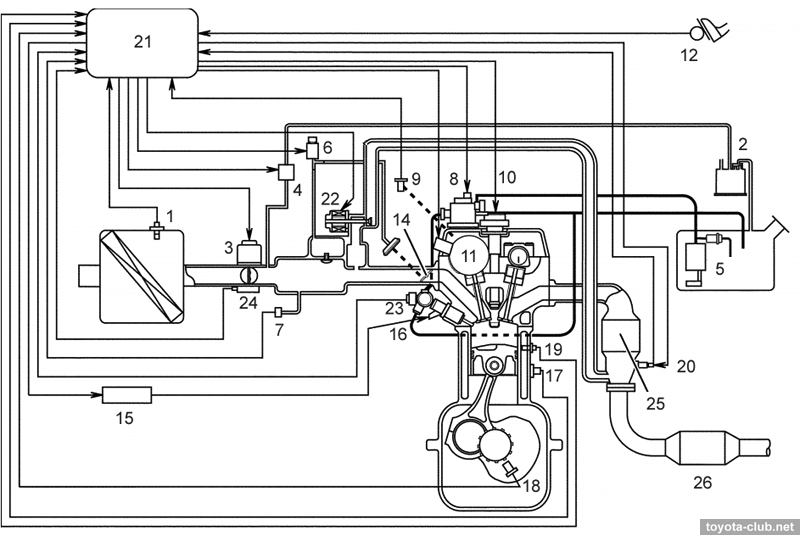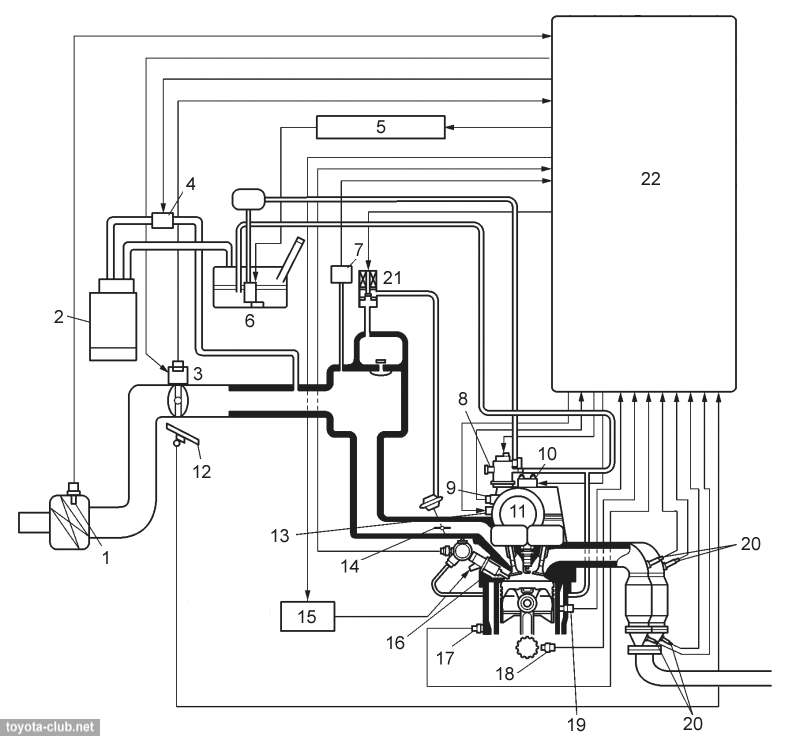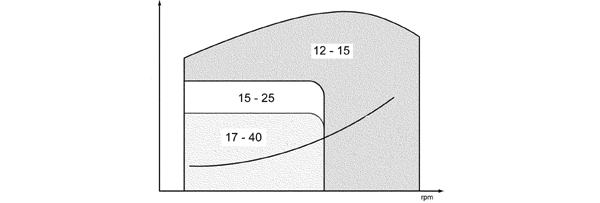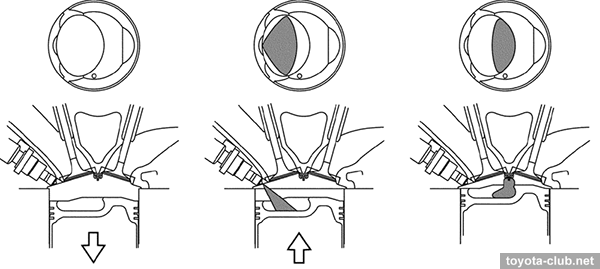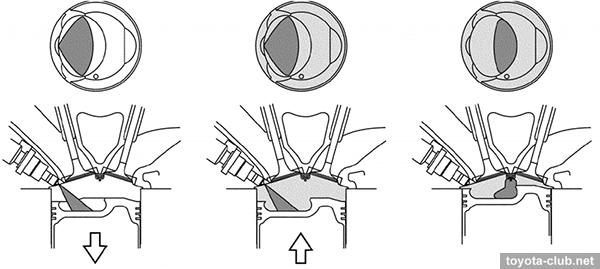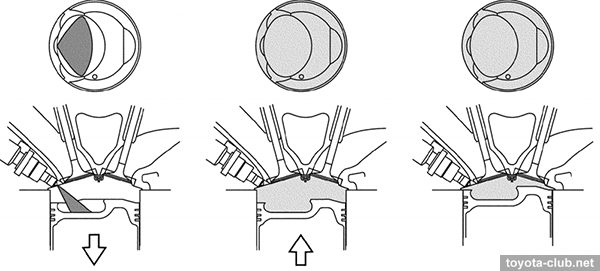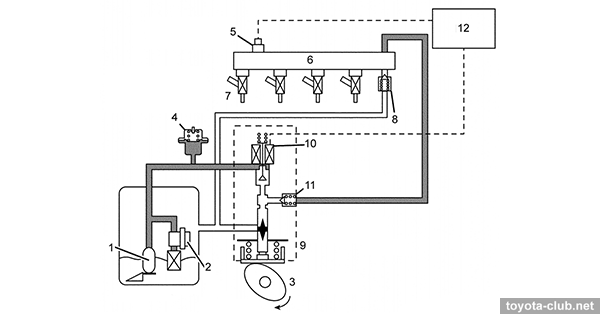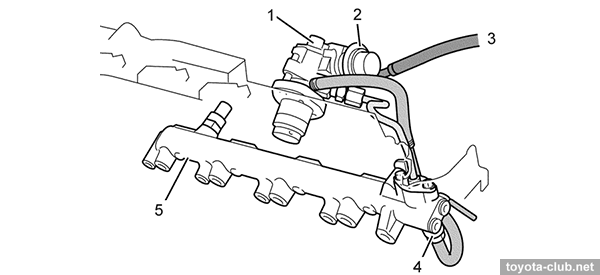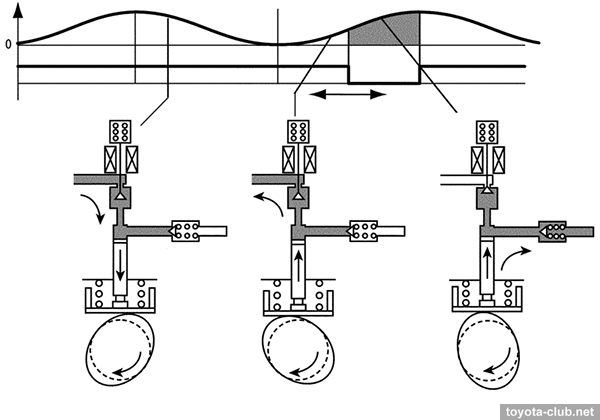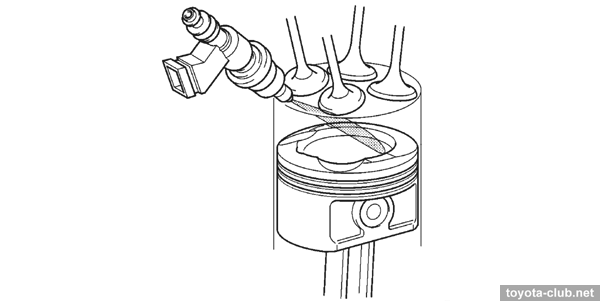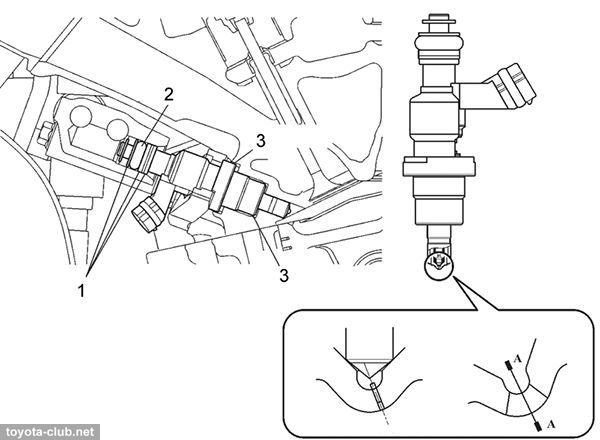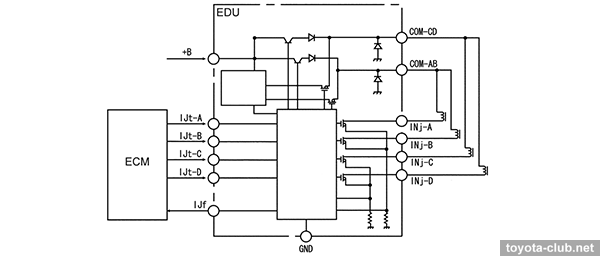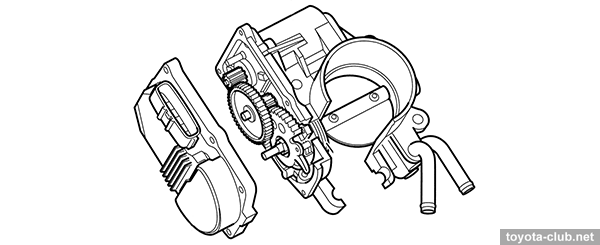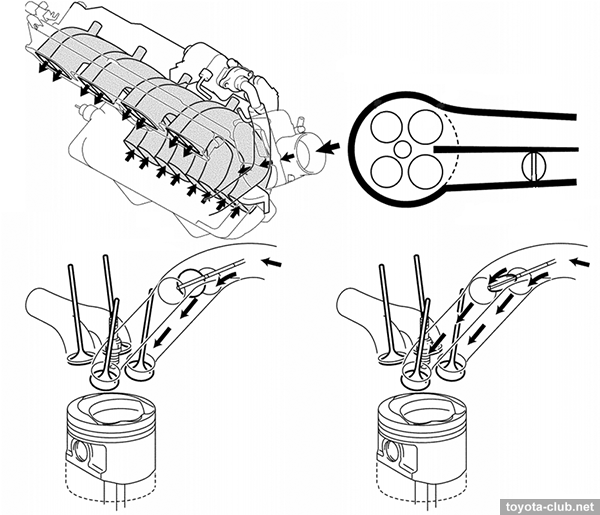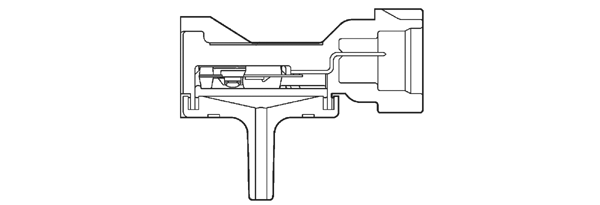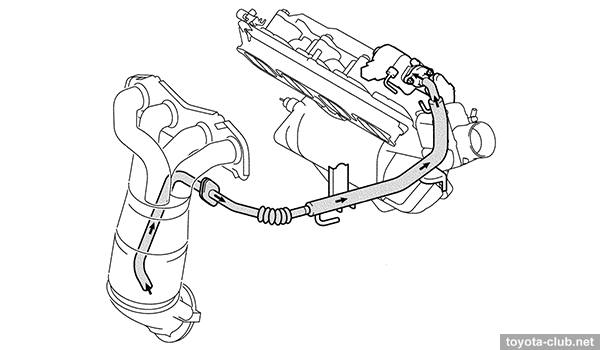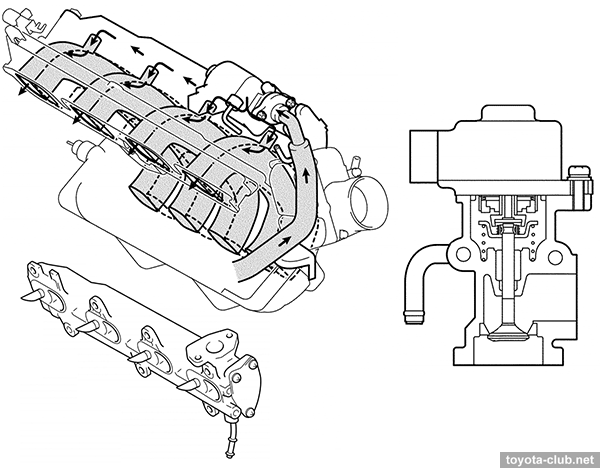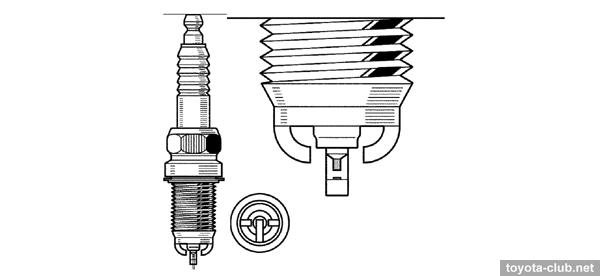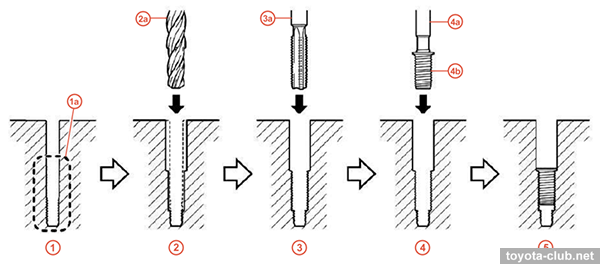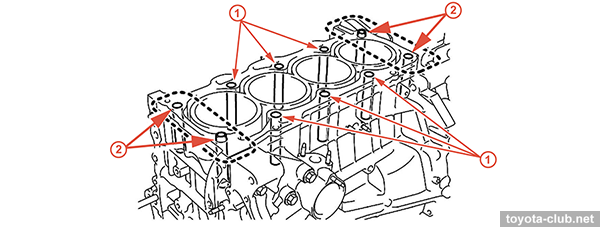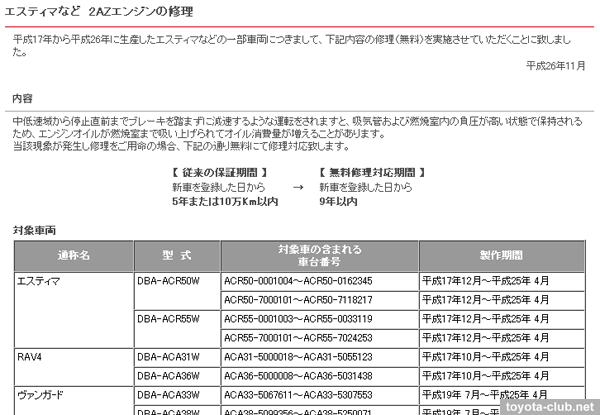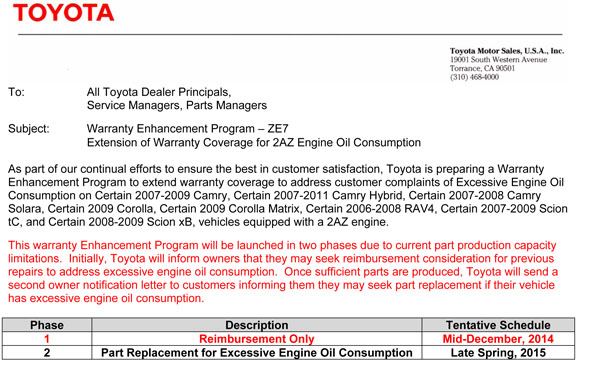Eugenio,77
AZ series was introduced since 2000 - to gradually supplant the legendary S series, and for ten years remained the main mid-size engine of company. Installed in many initially FF C/D/E-class cars, vans, light- and medium-SUVs. In turn, from the mid-2000s they were gradually replaced by engines of the ZR and AR series.
1AZ-FE (2.0 EFI VVT) - with multipoint injection.
Used for: Avensis 250..270, Avensis Verso/Picnic 20, Camry 30..40..50, RAV4 20..30, Wish 10.
Cylinder block The cylinder block - aluminium "open deck" with thin cast iron liners. The liners are fused into block and their special rough outer surface promotes strong connection. Of course, no overhaul with reboring officially provided.
The massive alloy crankcase mounted to block also performs the function of the sump upper part and the stiffener. Forged steel crankshaft with 5 journals and 8 balance weights is held by individual main bearing caps. The axis of the crankshaft has been shifted by 10 mm relative to the cylinder axis lines ("desaxage"), thus reducing the lateral component of the force exerted by the piston to the cylinder wall, reducing wear.
As usually for Toyota's R4 engines with displacement over two litres, the balancer mechanism is installed with direct drive from the crankshaft (by polymer gears - to reduce noise). But besides the improvement of comfort, it creates another potential weakness of the engine mechanical part.
At type'2006 there is the spacer in the water jacket, it allows more intensive coolant circulation near the top of the cylinder, which improves heat dissipation and helps to more evenly thermally load.
Cylinder head Cylinder head of traditional design, with a close to the vertical direction of the intake port for efficient intake and holes for injectors. Head cover is cast of magnesium alloy.
Timing drive Timing drive - 16-valve DOHC, driven by single-row roller chain (pitch 8 mm), with hydraulic tensioner (with ratchet mechanism) and lubricated by separate oil nozzle.
There is VVT (variable valve timing system) sprocket on the inlet camshaft, the range - 50° (type'2006 - 40°). The valve clearance is adjusted by a set of tappets, without adjusting washers or lash adjusters. Therefore, owners prefer to abstain from rather complex and expensive procedure of adjusting. .
It is quite difficult to predict the chain life time - rarely no need to replace it up to 300.000 km mileage, but more often stretches to 150.000 km (accompanied by by excessive noise, especially after start, and trouble codes concerning to timing). Together with chain replacement it would be appropriate also replace other components (sprockets, tensioner, guides), as used ones contribute to a rapid wear of a new chain, but as the inlet camshaft sprocket is assembled with VVT actuator (~$120) , so most owners does not follow this recommendation . The hydraulic tensioner requires relatively frequent replacements, but it can be perform easy from the outside, without removing of the chain cover. Lubrication system
Trochoid type oil pump is installed in the crankcase and is driven by additional chain. On the one hand, it increased the number of moving parts, on the other - the conditions of oil pumping improved.
Oil nozzles that lubricate and cool the pistons are provided.
The oil filter is located vertically under the engine. Cooling system The cooling system is classic for the 3rd wave engine: the pump driven by serpentine belt, the mechanical thermostat is "cold" (80-84°C), radiator fans are controlled by ECM via relays (without coolant temperature switch).
Intake and exhaust Manifolds location - as at the previous generation of engines - intake at rear, exhaust at front. Notable innovation - a plastic intake manifold (to reduce weight and cost, and reduce heating of the inlet air) - enough unproblematic even for winter conditions.
Some models have the muffler with a mechanical valve that regulates the flow of exhaust gases. At low speed closed valve helps to reduce noise, at high speeds it is opened reducing the back-pressure.
Fuel injection system (EFI) Fuel injection - traditional multipoint, sequential under normal conditions. In some conditions (low temperature and low speed) paired injection can be performed. In addition, injection can be also performed synchronized (once per cycle at the same position of the crankshaft, with managed time of injection) or unsynchronized (by all injectors simultaneously).
Fuel system - without a return line, with the pressure regulator and the fuel filter built in pump module, the fuel pressure - about 325 kPa. Pulsation damper mounted to aluminum fuel rail. The quick-split type connectors are used for fuel lines.
The injectors with multi-hole nozzle are used to improve dispersion of fuel.
The control system - "L-type SFI", with mass air flow sensor (MAF) "hot wire" type, combined with intake air temperature sensor. RON requirements - 91 / Regular.
In 2001-2003 the modification with mechanical throttle drive and classical idle control (by rotary solenoid) produced.
However, most models are initially was equipped with electronically controlled throttle valve (ETCS): DC motor, dual-channel potentiometer (by MY2003 replaced by contact-less sensor (Hall effect)), with a separate accelerator pedal position sensor (initially potentiometer, since type'2006 - Hall effect). ETCS functions is idle speed control, cruise control and torque control during gear changes.
There are few variants of oxygen sensor installation:
- pair of oxygen sensors (89465) before double converter - oxygen sensor (89465) before and after converter - one air-fuel ratio (AFS) sensor (89467) before converter and oxygen sensor (89465) after converter - pair of AFS sensors (89467) before double converter and pair of oxygen sensors (89465) after
Since type'2006 widely used planar type AFS (advantage - more rapid heating).
Crankshaft and camshaft position sensors still was traditional inductive type. In MY2003 "flat" piezoelectric knock sensor was introduced, unlike the old type of resonant knock sensors it feels a wider range of vibration frequencies.
At North American market ECM also had to perform control of too complex and capricious fuel vapour recovery system (EVAP). At type'2006 for some markets with strong emission standards IMRV actuator in the intake was installed, which closes half of intake ports at cold engine idling, thereby creates a strong turbulence and improves the efficiency of the combustion process.
Electrical Ignition system - DIS-4 (separate coil with integrated igniter for each cylinder). Spark plugs (Denso SK20R11, NGK IFR6A11) with the iridium central electrode.
Starter - with a planetary gear, segment armature winding, interpolation magnets. Alternator - after MY2003, new generators with a conductor segment. Since MY2006 overrun clutch was installed - with a spring between the inner and outer portions of the pulley which transmits torque only in the direction of rotation of the crankshaft, reducing the load to belt.
Auxiliary drive - by serpentine belt with automatic spring tensioner. The advantage - compact size, the disadvantages - more load to single belt, preferable to change tensioner simultaneously with the belt, inability to remove belt from one seized up unit (alternator, steering pump, compressor).
1AZ-FE engine can be seen as a simplified version of 2AZ-FE. - There is no balancing mechanism. - No oil nozzles in the block. - Pistons have larger skirt.
- For some regions specific modifications was produced - for leaded gasoline, without VVT, without converter and relative components.
There are some differences in the mechanical part of D-4 engines. - The higher the compression ratio. - The fuel injectors are mounted in cylinder head.
- High pressure fuel pump is driven by additional cam on the inlet camshaft. - Variable valve timing range 43°.
- The pistons has the specify shape which help to lead the fuel spray to the area of the spark plug. The top ring groove has anti-wear alumite coating.
- Some models was equipped with oil cooler.
- Differences of version for Japanese domestic market (type'2004): a compression ratio 10.5 instead of 9.8, three-layer cylinder head gasket instead of a two-layer, other shape of the combustion chamber, additional channels for coolant between the cylinders, the other valve timing, intake valve lift 9.4 instead of 8.2 mm, exhaust - 8.0 instead of 8.6 mm, reduced by 1.1 mm piston height. Fuel injection system (D-4)
Early 1AZ-FSE was equipped with D-type control system (with MAP sensor), but Avensis 250 and some versions for domestic market since 2004 received L-type system with MAF sensor.
For traditional engine with multipoint injection optimal stoichiometric mixture ratio (mass air-fuel ratio λ) is 14.7: 1, the mixture leaner than 20-24:1 is not ignited by the spark plug. The direct injection engine runs at ultra-lean mixture (λ = 30-40) - atomized fuel forms a cloud around the spark plug, and although in the whole combustion chamber mixture is very lean, near the spark it is close to the stoichiometric and can be ignited easily. Lean mixture in the remaining volume is less prone to detonation, which allows to increase the compression ratio and increase engine output. Due to the evaporation of injected fuel air charge in the cylinder is cooled further reduces the possibility of knocking and improves cylinder filling.
D-4 modes (domestic market) 1. Stratified combustion (LeanBurn). Implemented when driving at a constant speed and at low loads. Injection at the end of the compression stroke - the fuel is reflected from the recess of the piston, actively dispersed and vaporized, heading to the spark plug. Although the mixture in whole cylinder is lean (λ = 17-40), at spark plug area it is rich enough to be ignited by spark and fire the remaining volume.
2. Two-stage mixing. Implemented at mid-load for a smooth transition between modes of stratified and homogeneous combustion. Injection occurs twice - at intake and compression strokes, λ = 15-25.
3. Homogeneous combustion. Implemented when driving with load, during heating, at start, during brakes operation, during regeneration. Injection during the intake stroke, the fuel mixes with air and forms a homogeneous mixture with a composition close to the stoichiometric (λ = 12-15).
Fuel system The fuel from tank pump (pressure ~400 kPa) supplied to high pressure pump, than under pressure into the fuel rail, and finally into the cylinders by injectiors
Injection pump. Single-plunger with control valve, check valve and pulsation damper.
- At inlet stroke the plunger moves downward and fuel draws into the pumping chamber. - At the beginning of the compression stroke part of the fuel is returned while control valve is open (the specified fuel pressure is set in the range 8-13 MPa). - At the end of the compression stroke control valve is closed and the pressurized fuel through the check valve is supplied into the fuel rail.
Fuel rail. Made of aluminium alloy, contains fuel pressure sensor to provide feedback, and a mechanical pressure relief valve (opens the drain line to the tank if the pressure exceeds 14 MPa).
Injectors. Slotted injector nozzles produce fuel spray of various shapes (conical at homogeneous mode or narrow at stratified mode).
Injector driver (EDU). The injectors are controlled by a driver, which converts the signal from the control unit (12 V) in the high-voltage signal to the injectors, ensuring maximum operation speed.
Air intake system
ETCS (electronic throttle control). Driven by motor with control unit commands. When starting the throttle is slightly opened to allow additional air intake, and then the opening angle decreases depending on the coolant temperature. At the homogeneous mode idling speed is adjusted by throttle moving, at LeanBurn mode - by fuel supply volume correction with constant throttle opening. In addition, ETCS performs traction control (TRC) function and some stabilization system (VSC) functions.
SCV (swirl control valve) actuator. There is SCV block between the cylinder head and the inlet manifold, which closes one of two inlets channel to each cylinder, depending on the driving conditions. The flaps are driven by vacuum actuator.
- At low speed, low load, low coolant temperature SCV is closed, air flows through one port, that increases flow speed and forms a vortex in the cylinder, for better mixture turbulization. - At high load, SCV opens and air flows through the both ports.
Considering the air supply system features, additional pressure sensor for the brake servo was implemented, to switch the mode that provides the specified vacuum level.
EGR system (domestic market). Exhaust gas recirculation system of D-4 engines provides inlet of significant proportion of the exhaust gas at LeanBurn mode (much more than in traditional engines). It allows to low combustion temperature, decrease content of nitrogen oxides in the exhaust gases, reduce pumping losses at the inlet.
EGR valve is driven by DC step-motor, opening angle depends on the engine speed, coolant temperature, load and vehicle speed.
Exhaust gases from the valve flows into EGR aluminum manifold, which uniforms stream of gases in each cylinder. Both the valve and manifold are water cooled.
NOx-converter (domestic market). In the exhaust pipe of Japanese models NOx converter is installed. LeanBurn mode is accompanied by an increased emission of NOx, than the nitric oxide reacts with oxygen of the exhaust gas (O2), and products are accumulated on the catalyst adsorbing material in the form of nitrates (NO2). At homogeneous mode, with sufficiently rich mixture, the content of CO and HC in the exhaust gases increases, with its involvement in the presence of platinum dioxide (NO2) is reduced to nitrogen (N2). Simultaneously with the accumulation of nitrogen oxides converter actively captures the sulphur, which takes the useful volume of the absorbent layer, so the system can to function normally only using low-sulphur gasoline. Ignition system - DIS-4, spark plugs with iridium centre electrode (initially for overseas market - Denso SK20R11 / NGK IFR6A11, since MY2003 - Denso SK20BR11 with two additional side electrodes, for domestic market - SK20BGR11 - protruded in the combustion chamber due to long shroud).
Type'2004 differences: L-type control system with MAF sensor, ETCS actuator with throttle position sensor (Hall effect), absence of separate NO-converter.
Summary Toyota engines review |
|

